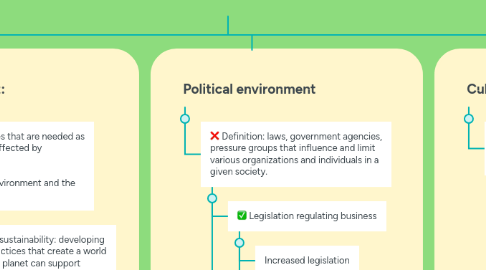
1. Economic environment:
1.1. Definition: factors that affect consumer purchasing power and spending patterns.
1.1.1. Changes in Consumer Spending: Value marketing offering financially cautious buyers greater value – the right combination of quality and service at a fair price.
2. Demographic
2.1. Definition: the study of human populations-- size, density, location, age, gender, race,occupation, and other statistics.
2.1.1. Demographic environment: involves people, and people make up markets.
2.1.2. Demographic trends: shifts in age, family structure, geographic population, educational characteristics, and population diversity.
2.1.3. Baby Boomers
2.1.3.1. Generation X
2.1.3.1.1. Millennials
2.1.4. Generational marketing: important in segmenting people by lifestyle instead of age.
2.1.5. Geographic Shifts in Population
2.1.5.1. Growth in U.S. West and South and decline in Midwest and Northeast
2.1.5.2. Change in the Workforce
2.1.5.2.1. More educated
2.1.5.2.2. More white collar
2.1.5.3. Change in where people work
2.1.5.3.1. Telecommuting
2.1.5.3.2. Home office
2.1.6. Changing American Family
2.1.6.1. Divorcing or separating
2.1.6.2. Choosing not to marry
2.1.6.3. Choosing to marry later
2.1.6.4. Marrying without intending to have children
2.1.6.5. Increasing number of working women
2.1.6.6. Increasing number of stay-at- home dads
2.1.7. Increasing Diversity
2.1.7.1. Markets are becoming more diverse
2.1.7.1.1. International
2.1.7.1.2. National
2.1.7.1.3. Ethnicity
2.1.7.1.4. Gay or lesiban
2.1.7.1.5. Disabled
3. Natural environment:
3.1. Definition: - Resources that are needed as inputs by marketers or affected by marketing activities. - Involve the physical environment and the natural resources.
3.1.1. Environmental sustainability: developing strategies and practices that create a world economy that the planet can support indefinitely.
3.1.2. Technological environment: forces that create new technologies, new products and marketing opportunities.
4. Political environment
4.1. Definition: laws, government agencies, pressure groups that influence and limit various organizations and individuals in a given society.
4.1.1. Legislation regulating business
4.1.1.1. Increased legislation
4.1.1.2. Changing government agency enforcement
4.1.2. Increased emphasis on ethics
4.1.2.1. Socially responsible behavior
5. Cultural Environment:
5.1. Definition: institutions and other forces that affect a society’s basic values, perceptions, and behaviors.
5.1.1. Persistence of Cultural Values:
5.1.1.1. Core beliefs and values: persistent and are passed on from parents to children and are reinforced by schools, churches, businesses, and government
5.1.1.2. Secondary beliefs and values: more open to change and include people’s views of themselves, others, organization, society, nature, and the universe
5.1.2. Shifts in Secondary Cultural Values:
5.1.2.1. People’s view of themselves: vary in their emphasis on serving themselves versus serving others.
5.1.2.2. People’s view of others: more “cocooning” – staying home, home cooked meals.
5.1.2.3. People’s view of organizations: decline of loyalty toward companies
5.1.2.4. People’s view of society
5.1.2.4.1. Patriots defend it
5.1.2.4.2. Reformers want to change it
5.1.2.4.3. Malcontents want to leave it
5.1.2.5. People’s view of nature
5.1.2.5.1. Some feel ruled by it
5.1.2.5.2. Some feel in harmony with it
5.1.2.5.3. Some seek to master it
5.1.2.6. People’s view of the universe
5.1.2.6.1. Renewed interest in spirituality
5.1.2.6.2. Developed more permanent values
5.1.2.6.3. Family, community, earth, spirituality, ethics

